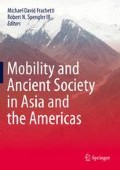Abstract
This book is an edited volume of essays by leading international scholars from half a dozen different countries and over a dozen different research institutes concerning the character, timing, and geography of large-scale migrations connecting Inner Asia to northeast Asia and eventually to all corners of the New World during the Upper Paleolithic (specifically between 17,000 and 13,000 years ago). The authors come from a variety of disciplines and apply several district methodologies to discuss “Great Migrations” in Asia and the Americas. The 12 chapters are the result of a 3-day international conference co-organized by the Embassy of the Republic of Kazakhstan and the Harriman Institute at Columbia University, the second international conference on “Great Migrations” spearheaded His Excellency Erlan Idrissov. This volume, as with the conference, deals with the timing, routes, cultural aspects, and human ecology of the demographic growth and diffusion of people across the Americas, as well as the earliest people to live in Inner and northeastern Asia.
Access this chapter
Tax calculation will be finalised at checkout
Purchases are for personal use only
Notes
- 1.
The exact dates for early modern human migrations out of Africa are still debated and several unsuccessful colonization waves may have preceded. Considerable literature exists discussing the Out of Africa model or the Recent African Origin model; see Mellars (2006).
- 2.
The retreating of glaciers in the mountains of the world today can serve as a loose indicator of how fast plants and animals colonize recently deglaciated land—in the case of the Tien Shan and Dzhungar in Central Asia herbaceous plants establish in as little as 10–20 years (personal observations).
References
Dillehay, T. D. (1989). Monte Verde: A late Pleistocene settlement in Chile: Paleoenviromental and site context (Vol. 1). Washington, DC: Smithsonian Institution Press.
Dillehay, T. D. (1997). Monte Verde: A late Pleistocene settlement in Chile: The archaeological context and interpretation (Vol. 2). Washington, DC: Smithsonian Institution Press.
Frachetti, M. D. (2011). Migration concepts in central Eurasian archaeology. Annual Review of Anthropology, 40, 195–212.
Lahr, M. M. (1995). Patterns of modern human diversification: Implications for Amerindians origins. Yearbook of Physical Anthropology, 38, 163–198.
Macaulay, V., Hill, C., Achilli, A., Rengo, C., Clarke, D., Meehan, W., et al. (2005). Single, rapid coastal settlement of Asia revealed by analysis of complete mitochondrial genomes. Science, 308, 1034–1036.
Mellars, P. (2006). Going east: New genetic and archaeological perspectives on the modern human colonization of Eurasia. Science, 313, 796–800.
Spengler, R. N., III. (2014). Niche dwelling vs. niche construction: Landscape modification in the bronze and iron ages of central Asia. Human Ecology, 42, 813–821. doi:10.1007/s10745-014-9697-x.
Spengler, R. N., III, Frachetti, M. D., & Fritz, G. J. (2013). Ecotopes and herd foraging practices in the bronze and iron age, steppe and mountain ecotone of central Asia. Journal of Ethnobiology, 33(1), 125–147.
Author information
Authors and Affiliations
Corresponding author
Editor information
Editors and Affiliations
Rights and permissions
Copyright information
© 2015 Springer International Publishing Switzerland
About this chapter
Cite this chapter
Frachetti, M.D., Spengler, R.N. (2015). Introduction. In: Frachetti, M., Spengler III, R. (eds) Mobility and Ancient Society in Asia and the Americas. Springer, Cham. https://doi.org/10.1007/978-3-319-15138-0_1
Download citation
DOI: https://doi.org/10.1007/978-3-319-15138-0_1
Publisher Name: Springer, Cham
Print ISBN: 978-3-319-15137-3
Online ISBN: 978-3-319-15138-0
eBook Packages: Humanities, Social Sciences and LawSocial Sciences (R0)

